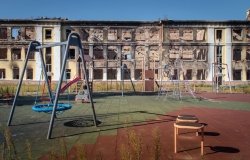
A blog of the Kennan Institute
Uniting Ukraine’s Ballet Dancers

The international ballet community responded immediately when the Russians invaded Ukraine on February 24, 2022. A number of companies around the world provided refuge to Ukrainian dancers. The Dutch—led by dancer Igone de Jongh—proved especially welcoming and, within weeks, an abandoned building in The Hague had been converted into a dance center for Ukrainian dancers and their families. The Ukrainian Ministry of Culture permitted the male dancers, who are of age to serve in the military, to leave Ukraine for these performances.
The result is a company made up of 60 dancers of all ranks from across Ukraine. The displaced dancers have toured Singapore, Australia, the UK, and major European ballet centers as the United Ukrainian Ballet Company in recent months. The troupe arrived for six performances at the Kennedy Center’s Opera House in Washington in early February.
Superstar choreographer Alexei Ratmansky—who grew up in Kyiv and danced with the National Ballet of Ukraine before heading out of Ukraine to sweep the entire ballet world off its feet—worked with the company to produce his version of the second oldest ballet still in repertoire, Giselle. Ratmansky’s take rejuvenated a work that had been overdone, by Soviet companies in particular.
Anything touching on Ukraine is political these days, especially in Washington. Nonetheless, the quality of the production and the dancers enabled the art to remain front and center. Odesa-born Christine Shevchenko, principal dancer of the American Ballet Theater; Iriyna Zhalovska, who has been a first soloist with Kyiv’s National Ballet; and Kyiv native Elizaveta Gogidze, also a first soloist in Kyiv, danced Giselle. Olekseii Tiutiunnyk, from the Kyiv company; Donetsk-trained Oleksei Kniazkov of the Kharkiv Theater of Opera and Ballet; and Odesa-trained Denys Nedak, who recently joined the Atlanta Ballet, performed the role of Albert.
Pulled together from disparate components, the United Ukrainian Ballet appeared to Kennedy Center audiences and Washington critics as a fully polished ensemble. Lisa Trainer, covering the performances for the DC Theater Arts website on February 3, 2023, wrote, “betrothal, betrayal, and the ultimate forgiveness: these are the themes that shape Giselle into one of the beloved ballets of the Romantic canon.” She continued, “This week exuding resilience, courage, and patriotism, an ad hoc ballet company named the United Ukrainian Ballet re-invigorates this warhorse of a ballet, while demonstrating the indomitable spirit of the Ukrainian people.”
Trainer continued, “Together this ad hoc group is breathtaking in conception and physical prowess, rallying to create a unified company, which can take years or decades, in just months, while their homeland is fighting for its survival. That sense of urgency, particularly in act II, is palpable and came to a pinnacle with the bows and curtain calls on opening night.” The result, for Trainer, brought new insights to an important but rarely probed work. “Throughout both acts,” she concludes, “small and large details provide for a more compelling Giselle than I’ve seen in decades of dance-going.”
Writing in the respected Broadway World website also for February 3, reviewer Mary Lincer said that “Giselle, like Hamlet for actors, Carmen for mezzo-sopranos, and Mrs. Lovett for musical theatre singer/actors of a certain age, brings audiences to the theatre to get to know the skills of the latest acclaimed ballerina.” She continued, “Ukrainian-Russian choreographer Alexei Ratmansky, former director of the Bolshoi Ballet, current artist in residence for American Ballet Theatre, soon to be artist in residence for New York City Ballet, has brought … a company of exiled, excellent Ukrainian dancers.”
Lincer said that Shevchenko’s opening night performance “caused small gasps in the house,” and Oleksei Tiutiunnyk, “handled masses of mime, character work, and choreography with distinction.” She added, “jumping slowly and following the jump with absolute stillness, much harder than it looks, marked his skill.” The group, Lincer concluded, has given the world a “fine new company.”
Following the Kennedy Center performances, some of the dancers returned to the National Ballet of Ukraine in Kyiv. The National Ballet has begun intermittent performances (all too often interrupted by air raid sirens) at the Kyiv Opera House. Others, such as Shevchenko and Ratmansky, went to New York. Many will remain in The Hague. Whether in the Hague, Ukraine, or elsewhere, this company demonstrates the continuing power of Ukrainian ballet.
The opinions expressed in this article are those solely of the author and do not reflect the views of the Kennan Institute.
See our newest content first.
Subscribe to receive the latest analysis from the Focus Ukraine blog.
About the Author

Blair A. Ruble
Former Wilson Center Vice President for Programs (2014-2017); Director of the Comparative Urban Studies Program/Urban Sustainability Laboratory (1992-2017); Director of the Kennan Institute for Advanced Russian Studies (1989-2012) and Director of the Program on Global Sustainability and Resilience (2012-2014)

Kennan Institute
The Kennan Institute is the premier US center for advanced research on Eurasia and the oldest and largest regional program at the Woodrow Wilson International Center for Scholars. The Kennan Institute is committed to improving American understanding of Russia, Ukraine, Central Asia, the South Caucasus, and the surrounding region though research and exchange. Read more













